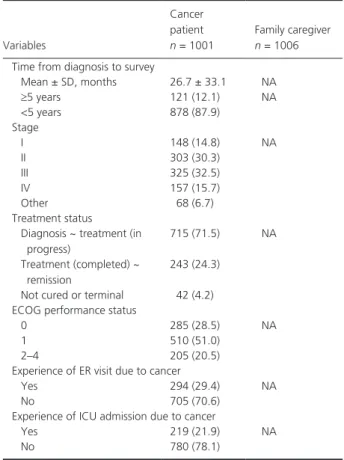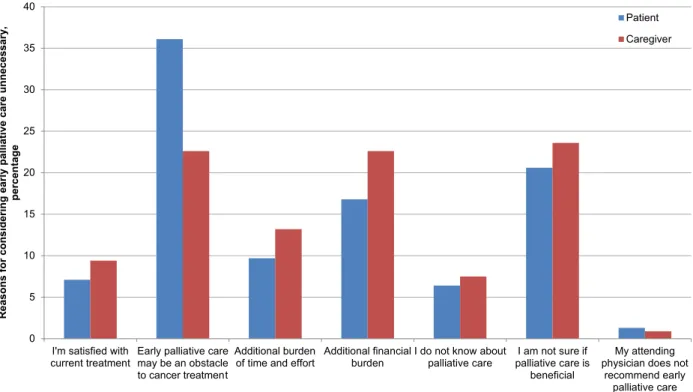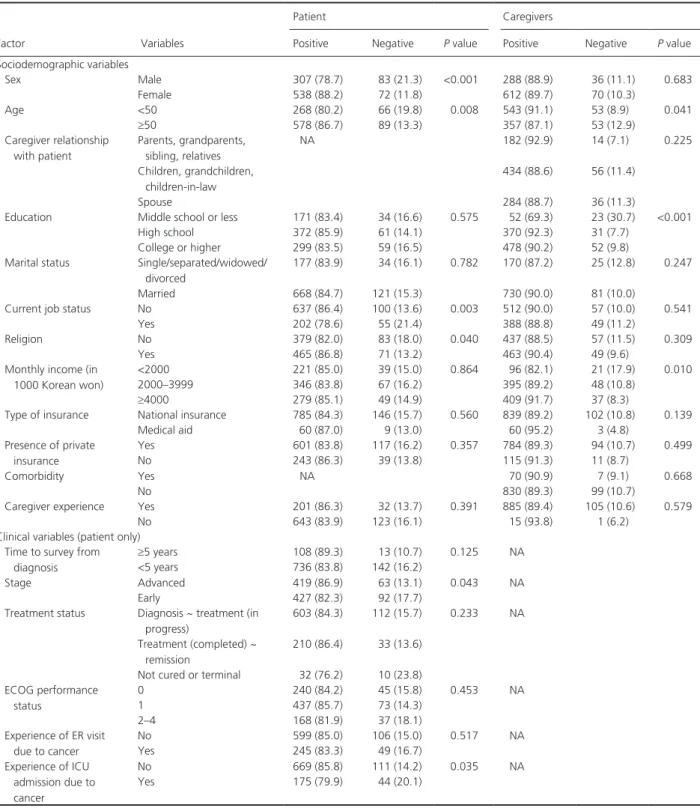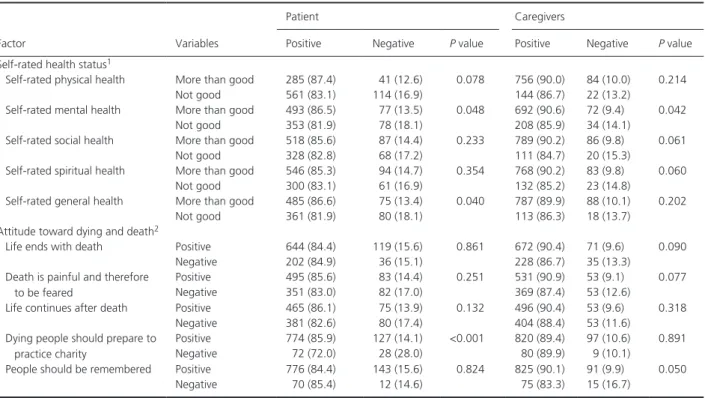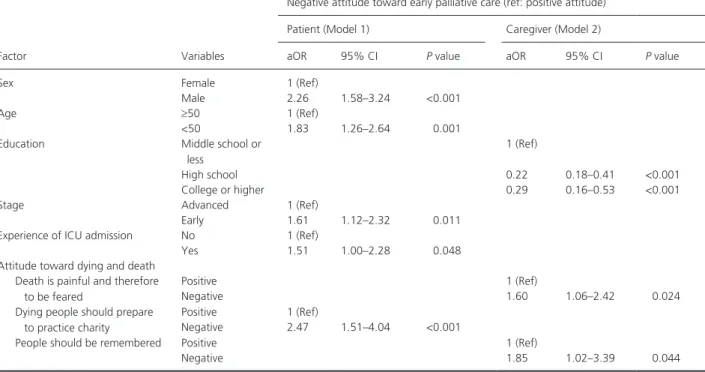ORIGINAL RESEARCH
Attitudes toward early palliative care in cancer patients and caregivers: a Korean nationwide survey
Shin Hye Yoo 1, *, Miso Kim 1, *, Young Ho Yun 2 , Bhumsuk Keam 1 , Young Ae Kim 3 , Yu Jung Kim 4 , Hyun-Jeong Shim 5 , Eun-Kee Song 6 , Jung Hun Kang 7 , Jung Hye Kwon 8 , Jung Lim Lee 9 , Soon Nam Lee 10 , Si-Young Kim 11 , Eun Joo Kang 12 , Young Rok Do 13 , Yoon Seok Choi 14 & Kyung Hae Jung 15
1
Department of Internal Medicine, Seoul National University Hospital, Seoul, Korea
2
Department of Family Medicine, Seoul National University College of Medicine, Seoul, Korea
3
Cancer Survivorship Branch, National Cancer Control Institute, National Cancer Center, Goyang, Korea
4
Department of Internal Medicine, Seoul National University Bundang Hospital, Seoul National University College of Medicine, Seongnam, Korea
5
Division of Hematology and Medical Oncology, Department of Internal Medicine, Chonnam National University School of Medicine, Hwasun, Korea
6
Division of Hematology/Oncology, Chonbuk National University Medical School, Jeonju, Korea
7
Department of Internal Medicine, Postgraduate Medical School, Gyeongsang National University, Jinju, Korea
8
Department of Internal Medicine, Kangdong Sacred Heart Hospital, Hallym University, Seoul, Korea
9
Department of Hemato-oncology, Daegu Fatima Hospital, Daegu, Korea
10
Department of Internal Medicine, Ewha Womans University College of Medicine, Seoul, Korea
11
Departments of Medical Oncology and Hematology, Kyung Hee University Hospital, Seoul, Korea
12
Department of Internal Medicine, Korea University Guro Hospital, Seoul, Korea
13
Departments of Internal Medicine, Dongsan Medical Center, Keimyung University School of Medicine, Daegu, Korea
14
Departments of Internal Medicine, Chungnam National University Hospital, Daejeon, Korea
15
Departments of Internal Medicine, Asan Medical Center, Ulsan University College of Medicine, Seoul, Korea
Keywords
Attitude, cancer, caregiver, early palliative care, patient
Correspondence
Young Ho Yun, Department of Family Medicine, Seoul National University College of Medicine, 103 Daehak-ro, Jongno-gu, Seoul 110-799, Korea.
Tel: +82-2-740-8417;
Fax: +82-2-742-5947;
E-mail: lawyun08@gmail.com
Received: 16 November 2017; Revised: 16 February 2018; Accepted: 19 February 2018
Cancer Medicine 2018; 7(5):1784–1793
doi: 10.1002/cam4.1441
*These authors equally contributed for this work.
Abstract
Integrated early palliative care (EPC) improves quality of life and reduces psy- chological distress in adult patients with cancer and caregivers, but attitudes toward EPC have been poorly studied. We aimed to investigate attitudes toward EPC in a nationwide survey of patients with cancer and caregivers. From July to October 2016, we administered nationwide questionnaires examining attitudes toward EPC in patients with cancer (n = 1001) and their families (n = 1006) from 12 Korean hospitals. When an individual considered EPC unnecessary, the reasons were collected and analyzed. Factors associated with perception of EPC were examined. A majority of patients (84.5%) and caregivers (89.5%) had positive attitudes toward EPC. The most common reasons for deeming EPC unnecessary were that EPC may be an obstacle to cancer treatment (pa- tients: 37%; caregivers: 23%; respectively) or that they were not sure if EPC is beneficial (patients: 21%; caregivers: 24%; respectively). Financial burden as a reason was more evident in caregivers (23%) than in patients (17%). Male gender, age <50, early stage, intensive care unit admission, and not believing that dying people should prepare to practice charity were associated with pa- tients’ negative attitudes. In caregivers, opposition to EPC was associated with not thinking death should be feared, not thinking people should be remembered, and lower educational level. Our findings showed that significant numbers of patients with advanced cancer and family caregivers showed positive attitudes toward EPC. However, more than 10% of participants did not consider EPC necessary. Physicians’ communication with patients and caregivers and financial support could help overcome the barriers of EPC.
Funding Information
Ministry of Health & Welfare, Republic of Korea (Grant Number: HC15C1391), and Seokchun Daewoong Foundation (Grant Number: 80020160249).
Cancer Medicine
Open Access
Introduction
Patients with advanced cancer struggle with huge physical, psychological, socioeconomical, and mental health burdens.
Needs of patients and caregivers for palliative care (PC) to alleviate these problems are growing, but PC is usually provided only as end- of- life hospice care [1, 2], causing significant unmet need in patients with advanced cancer.
Early integration of PC into oncologic care, which is called early palliative care (EPC), indicates that PC should be administered to patients with advanced cancer earlier than in current practice, such as within 8 weeks after cancer diagnosis [3–6]. According to recent reports, EPC improves quality of life, psychological distresses, and understanding of disease and treatment compared to standard oncologic care alone [7–9]. Moreover, one study demonstrated a survival gain associated with EPC [7].
Based on these studies, several reviews and guidelines, such as the recent update to the American Society of Clinical Oncology Clinical Practice Guidelines [4–6], recom- mend that PC should be concurrently provided with standard oncologic care in patients with advanced non- small- cell lung cancer.
However, EPC has not been routinely integrated into cancer management as a part of standard practice in Asian countries, including Korea [10]. To promote this integra- tion, it is important to understand the attitudes and perceptions of patients with cancer and family caregivers.
Although attending physicians can influence early integra- tion by determining the timing of PC referral, under- standing patient and caregiver perceptions of EPC may help reduce the physician factors that are a barrier to EPC. Some physicians may avoid early referral to PC services due to a belief that patients and caregivers may react with concern about not receiving active anticancer treatments [11, 12]. However, there has been little inves- tigation into the attitudes toward EPC in adult patients with cancer and family, although a survey of pediatric patients with cancer and parents reported that few opposed receiving EPC [13]. If the patient and caregiver reaction to EPC is optimistic, then physicians may advocate for PC integration at earlier stages of disease. Hence, we aimed to examine the attitudes toward EPC in patients with cancer and family caregivers in a nationwide study.
Methods
Participants and procedures
Patients with cancer and family caregivers were surveyed from 12 large hospitals in South Korea from July to October in 2016. Medical oncologists were asked to identify patients with cancer at outpatient clinics. The process of participant
selection was previously described in detail [14]. Patients and caregivers who consented to participate were eligible if they were ≥18 years old, could fill out the questionnaire by themselves and communicate well with assistants, and understood the purpose of this study. Of 6024 consecutive patients surveyed, 1001 patients with cancer were included in our study (response rate 16.6%). For each patient at the outpatient clinic, a research assistant provided infor- mation about the study to the patient’s primary caregiver.
Of 5017 total family caregivers, we included 1006 in our study (response rate 20.1%). We did not include patients and caregivers from the community in this study. As part of the informed consent process, a trained research assistant provided a document written in standard Korean language that elaborated the study’s objectives. The participant was then asked to comment on their understanding of the document. If the participant had speech or hearing limita- tions, he or she was then excluded from the study. Other than this screening, we did not test the cognitive capacity of participants in the questionnaire. Patients and caregivers who were included received information about the study and completed a self- reporting questionnaire with the aid of research assistants. All provided written informed con- sent, and the study was approved by the institutional review board of each hospital (IRB Number: E- 1612- 102- 815).
We conducted the study in accordance with the principles of the Declaration of Helsinki.
Measurements
The structured questionnaire utilized in the survey included this question: “Currently, palliative care service is only provided for patients in a terminal state in Korea. Some people insist that palliative care should be provided earlier than the terminal stages of illness. Early palliative care is defined as palliative care services that try to control symp- toms, such as pain, and to give emotional and psychosocial support before the terminal state, even as early as diagnosis.
Do you think early palliative care is necessary?” Scores
ranged from 1 to 4 (1 = strongly necessary, 2 = necessary,
3 = unnecessary, and 4 = strongly unnecessary). We also
examined reasons for considering EPC unnecessary. The
following seven possible answers were provided: (1) I am
satisfied with current treatment, (2) early palliative care
may be an obstacle to cancer treatment, (3) early palliative
care is an additional burden of time and effort, (4) early
palliative care is an additional financial burden, (5) I do
not know about palliative care, (6) I am not sure if pal-
liative care is beneficial, and (7) my attending physician
does not recommend early palliative care. If the respondents
wanted to provide a different reason than one listed, they
could write a new answer in a blank eighth space. The
term “terminal state” was defined on the questionnaire as
a state of progressive advanced disease that, in the physi- cian’s judgment, was refractory to conventional anticancer treatments, such as surgery, chemotherapy, radiotherapy, or hormone therapy, and wherein the patient was expected to die within months. We have modified the definitions of PC by the World Health Organization [15] and the National Comprehensive Cancer Network [16] and speci- fied the following definitions in the questionnaire: “Palliative care is an approach that focuses on the management of pain and other distressing symptoms and provides patients and their families with comprehensive psychosocial and spiritual care. In addition, palliative care experts, including social workers and chaplains, work together as an inter- disciplinary team.” Five domains of self- rated health sta- tus—physical, mental, social, spiritual, and general—were each evaluated on a scale of 1–5 (Excellent, Very Good, Good, Poor, and Very Poor). Details of attitudes toward dying and death were described in a previous report [14].
Willingness to communicate with family about dying and death was scored from 1 to 4 (Very Much, Much, Little, and Never). Sociodemographic information (age, sex, level of education and income, current job status, religion, type of insurance, and status of private insurance) was examined for both patients and caregivers, whereas clinical informa- tion (site of malignancy, stage, treatment status, Eastern Cooperative Oncology Group [ECOG] performance status, experience of emergency room visit, and intensive care unit [ICU] admission) was investigated only for patients.
Statistical analysis
Sociodemographic and clinical characteristics of patients and caregivers were presented as numbers and percent- ages. Attitudes toward EPC were compared using chi- square tests between two groups. The response to any question as “strongly necessary” or “necessary” was considered as having a positive attitude in that category. We treated answers to questions about attitudes of early palliative care as dichotomous outcomes: either positive or negative.
Self- rated health status was dichotomized (More than Good [Excellent, Very Good, or Good] vs. Not Good [Poor or Very Poor]). We investigated the associations of sociode- mographic and clinical characteristics, self- rated health status, and attitudes toward dying and death with negative attitudes toward EPC separately for patients with cancer and caregivers. Because most factors included in the analysis were categorical variables, a normality test was unneces- sary. We also did not need to test for normality because we transformed continuous variables to categorical vari- ables to perform simple comparisons and logistic regression analyses. Univariate comparisons were performed using chi- square tests. Backward- selected multivariable logistic regression analysis in models that included statistically
significant variables significant from the univariate analysis with P < 0.10 was utilized to identify predictors for nega- tive attitude for EPC. The number of missing values from all dependent and independent variables was very low (34 of 40,125 [0.08%]). Because we did not observe skew- ing in the missing values, the occurrence of missing data was assumed to be randomly distributed. Thus, we per- formed an available case analysis. To identify any outliers of the continuous variables, we drew a distribution of continuous variables and found no outliers. We used STATA version 12 software (StataCorp LP, College Station, TX, USA) for all analyses and calculated two- sided P- values that were considered significant when P < 0.05.
Results
Baseline characteristics of patients with cancer and family caregivers
A total of 2007 participants were included in this analysis.
Sociodemographic and clinical characteristics of patients with cancer and family caregivers are shown in Table 1.
Attitudes toward early palliative care
Positive attitude toward EPC was evident in both patients (84.5%, n = 846) and caregivers (89.5%, n = 900), and more likely to be seen in caregivers (P < 0.001). For patients and caregivers who thought that EPC was unnecessary or strongly unnecessary, the reasons are shown in Figure 1.
Patients presuming EPC unnecessary were frequently worried whether EPC may be an obstacle to cancer treatment (37%, n = 56) or not sure whether EPC is beneficial (21%, n = 32).
These reasons were also commonly reported by the caregivers (23%, n = 24, and 24%, n = 25, respectively). Financial burden as a reason was noted more in caregivers (23%, n = 24) than in patients (17%, n = 26). Other reasons for negative attitudes toward EPC were additional burden of time and effort, 10% (n = 15) in patients and 13% (n = 14) in caregivers; satisfaction with current treatment, 7% (n = 11) in patients and 9% (n = 10) in caregivers; unawareness of PC, 7% (n = 10) in patients and 7% (n = 8) in caregivers;
and attending physician’s nonrecommendation, 1% (n = 2) in patients and 1% (n = 1) in caregivers.
Factors associated with negative attitudes toward early palliative care
We analyzed factors associated with negative attitudes
toward EPC separately for patients and caregivers by soci-
odemographic and clinical characteristics, self- rated health
status, and attitude toward death. For patients, negative
attitude toward EPC was associated with male sex, age
<50 years, employment, the absence of religion, early cancer stage, and having experienced ICU admission. For caregivers, those who were older than 50 years, had a lower educational level, and earned less showed more negative attitudes toward EPC (Table 2). Poor physical health status, mental health status, and general health status were associated with negative attitude toward EPC among patients, whereas this was true of poor mental, social, and spiritual health status among caregivers (Table 3). For patients, negative attitude toward EPC was associated with a negative response regarding whether
Table 1. Sociodemographic and clinical characteristics of (A) 2007 peo- ple (B) 1001 patients with cancer who participated in a survey about attitudes toward early palliative care.
Variables
Cancer patient
n = 1001Family caregiver
n = 1006(A)
Gender
Male 390 (39.0) 324 (32.2)
Female 610 (61.0) 682 (67.8)
Age, years
<50 334 (33.4) 596 (59.2)
≥50 667 (66.6) 409 (40.8)
Caregiver relationship with patient Parents, grandparents,
sibling, relatives
NA 196 (19.5)
Children, grandchildren, children- in- law
490 (48.7)
Spouse 320 (31.8)
Level of education
Middle school or less 205 (20.6) 75 (7.4)
High school 433 (43.5) 401 (39.9)
College or higher 358 (35.9) 530 (52.7) Marital status
Single/separated/widowed/
divorced
212 (21.1) 195 (19.4)
Married 789 (78.9) 811 (80.6)
Current job status
No 737 (74.1) 569 (56.6)
Yes 257 (25.9) 437 (43.4)
Presence of religion
No 462 (46.3) 494 (49.1)
Yes 536 (53.7) 512 (50.9)
Monthly income (in 1000 Korean won)
<2000 260 (26.0) 117 (11.6)
2000–2999 196 (19.6) 183 (18.2)
3000–3999 217 (21.7) 260 (25.8)
≥4000 328 (32.7) 446 (44.4)
Type of insurance
National Health Insurance 931 (93.1) 941 (93.7)
Medical aid 69 (6.9) 63 (6.3)
Presence of private insurance
Yes 717 (71.8) 878 (87.5)
No 282 (28.2) 126 (12.5)
Comorbidity
Yes 70 (7.0)
177 (7.7)
No 931 (93.0) 929 (92.3)
Caregiver experience
2Yes 233 (23.3) 990 (98.4)
No 766 (76.7) 16 (1.6)
(B)
Cancer type
Stomach cancer 147 (14.7) NA
Lung cancer 104 (10.4)
Hepato- pancreato- biliary cancer
101 (10.1)
Colorectal cancer 128 (12.8)
Breast cancer 229 (22.9)
Hematologic malignancy 106 (10.6)
Others
3184 (18.4)
(Continued)
Variables
Cancer patient
n = 1001Family caregiver
n = 1006Time from diagnosis to survey
Mean ± SD, months 26.7 ± 33.1 NA
≥5 years 121 (12.1) NA
<5 years 878 (87.9)
Stage
I 148 (14.8) NA
II 303 (30.3)
III 325 (32.5)
IV 157 (15.7)
Other 68 (6.7)
Treatment status
Diagnosis ~ treatment (in progress)
715 (71.5) NA
Treatment (completed) ~ remission
243 (24.3)
Not cured or terminal 42 (4.2) ECOG performance status
0 285 (28.5) NA
1 510 (51.0)
2–4 205 (20.5)
Experience of ER visit due to cancer
Yes 294 (29.4) NA
No 705 (70.6)
Experience of ICU admission due to cancer
Yes 219 (21.9) NA
No 780 (78.1)
NA, not applicable; SD, standard deviation; ECOG, the Eastern Cooperative Oncology Group; ER, emergency room; ICU, intensive care unit.
1
For patients with cancer, we counted the number of nonmalignant co- morbidities including human immunodeficiency virus infection, chronic disease including diabetes mellitus, hypertension, lung disease, liver dis- ease, heart failure, kidney disease, and arthritis (rheumatoid arthritis, osteoarthritis), stroke, Parkinson’s disease, dementia, and incurable ge- netic and neurologic disorders.
2
Caregiver experience means the presence of illness experience of loved one.
3
Others include cancers of uterus, ovary, prostate, genitourinary except prostate, testis, central nervous system, head and neck, esophagus, and thyroid, germ cell tumor, osteosarcoma, skin cancer (melanoma, non- melanoma), and neuroendocrine tumor.
Table 1. (Continued).
dying people should prepare to practice charity. Among caregivers, negative attitude toward EPC was associated with disagreement with the following ideas: death as the ending of life, death is painful and therefore to be feared, and people should be remembered (Table 3).
In backward- selected multivariable logistic regression analyses (Table 4), we included factors that were associ- ated in univariate analysis with negative attitude toward EPC. We constructed two models: model 1 for patients and model 2 for caregivers. In model 1, negative attitude toward EPC was statistically significantly associated with male gender (adjusted odds ratio [aOR], 2.26; 95% con- fidence interval (CI), 1.58–3.24), age <50 years (aOR, 1.83;
95% CI, 1.26–2.64), early cancer stage (aOR, 1.61; 95%
CI, 1.12–2.32), ICU admission (aOR, 1.51; 95% CI 1.00–
2.28), and belief regarding preparing to practice charity (aOR, 2.47, 95% CI, 1.51–4.04). Model 2 showed that negative attitude toward EPC was significantly associated with not believing death is painful and should be feared (aOR, 1.60; 95% CI, 1.06–2.42) and not thinking people should be remembered (aOR, 1.85; 95% CI, 1.02–3.39).
Lower educational level showed an inverse association with negative attitude toward EPC in caregivers.
Discussion
Our study showed that a significant portion of both patients with advanced cancer and family caregivers showed
positive attitudes toward EPC. A high proportion of posi- tive responses indicate that these groups are eager to receive EPC, even if EPC is not introduced as a routine clinical practice in Korea yet. However, more than 10%
of participants did not regard EPC as a necessary com- ponent for cancer management, and the reasons for nega- tive attitudes toward EPC differed between patients with cancer and caregivers. These findings suggest that further implementation could be designed to target those barriers specifically.
Despite the improvements in quality of life, psychologi- cal distresses, symptom burden, and prognostic under- standing provided by EPC, there are many barriers against EPC in patients with advanced cancer. Among them, patient and caregiver perception of EPC is important because it can prevent or alter use of the service.
Nevertheless, most studies on attitudes and barriers to EPC have focused on healthcare providers rather than adult patients and caregivers [11, 17, 18]. Studies on attitudes toward PC among patients with cancer and families have been widely performed [19], but that lit- erature is mostly limited to PC during the end stages for patients with terminal cancer. Attitudes toward EPC should be distinguished from those toward end- of- life PC because EPC is not just a simple combination of PC and anti- cancer treatment. For patients and families, these results mark a transition from the belief that PC is provided only when cancer treatment is over to a new paradigm
Figure 1. Reasons provided by patients with cancer and family caregivers for considering early palliative care to be unnecessary.
0 5 10 15 20 25 30 35 40
I'm satisfied with
current treatment Early palliative care may be an obstacle to cancer treatment
Additional burden
of time and effort Additional financial
burden I do not know about
palliative care I am not sure if palliative care is
beneficial
My attending physician does not
recommend early palliative care Reasons for considering early palliative care unnecessary, percentage
Patient Caregiver
in which EPC is considered a part of the early treatment process in a comprehensively integrated care plan [5].
The high proportion of positive responses toward EPC in our study is consistent with the results from a study
on perceptions of EPC in pediatric patients with cancer and their families [13]. That study demonstrated that very few children or parents expressed oppositions to EPC or perceived barriers to EPC, and patients showed more
Table 2. Factors associated with negative attitude toward early palliative care by sociodemographic and clinical characteristics.
Factor Variables
Patient Caregivers
Positive Negative
P valuePositive Negative
P valueSociodemographic variables
Sex Male 307 (78.7) 83 (21.3) <0.001 288 (88.9) 36 (11.1) 0.683
Female 538 (88.2) 72 (11.8) 612 (89.7) 70 (10.3)
Age <50 268 (80.2) 66 (19.8) 0.008 543 (91.1) 53 (8.9) 0.041
≥50 578 (86.7) 89 (13.3) 357 (87.1) 53 (12.9)
Caregiver relationship with patient
Parents, grandparents, sibling, relatives
NA 182 (92.9) 14 (7.1) 0.225
Children, grandchildren, children- in- law
434 (88.6) 56 (11.4)
Spouse 284 (88.7) 36 (11.3)
Education Middle school or less 171 (83.4) 34 (16.6) 0.575 52 (69.3) 23 (30.7) <0.001
High school 372 (85.9) 61 (14.1) 370 (92.3) 31 (7.7)
College or higher 299 (83.5) 59 (16.5) 478 (90.2) 52 (9.8)
Marital status Single/separated/widowed/
divorced
177 (83.9) 34 (16.1) 0.782 170 (87.2) 25 (12.8) 0.247
Married 668 (84.7) 121 (15.3) 730 (90.0) 81 (10.0)
Current job status No 637 (86.4) 100 (13.6) 0.003 512 (90.0) 57 (10.0) 0.541
Yes 202 (78.6) 55 (21.4) 388 (88.8) 49 (11.2)
Religion No 379 (82.0) 83 (18.0) 0.040 437 (88.5) 57 (11.5) 0.309
Yes 465 (86.8) 71 (13.2) 463 (90.4) 49 (9.6)
Monthly income (in 1000 Korean won)
<2000 221 (85.0) 39 (15.0) 0.864 96 (82.1) 21 (17.9) 0.010
2000–3999 346 (83.8) 67 (16.2) 395 (89.2) 48 (10.8)
≥4000 279 (85.1) 49 (14.9) 409 (91.7) 37 (8.3)
Type of insurance National insurance 785 (84.3) 146 (15.7) 0.560 839 (89.2) 102 (10.8) 0.139
Medical aid 60 (87.0) 9 (13.0) 60 (95.2) 3 (4.8)
Presence of private insurance
Yes 601 (83.8) 117 (16.2) 0.357 784 (89.3) 94 (10.7) 0.499
No 243 (86.3) 39 (13.8) 115 (91.3) 11 (8.7)
Comorbidity Yes NA 70 (90.9) 7 (9.1) 0.668
No 830 (89.3) 99 (10.7)
Caregiver experience Yes 201 (86.3) 32 (13.7) 0.391 885 (89.4) 105 (10.6) 0.579
No 643 (83.9) 123 (16.1) 15 (93.8) 1 (6.2)
Clinical variables (patient only) Time to survey from
diagnosis
≥5 years 108 (89.3) 13 (10.7) 0.125 NA
<5 years 736 (83.8) 142 (16.2)
Stage Advanced 419 (86.9) 63 (13.1) 0.043 NA
Early 427 (82.3) 92 (17.7)
Treatment status Diagnosis ~ treatment (in progress)
603 (84.3) 112 (15.7) 0.233 NA
Treatment (completed) ~ remission
210 (86.4) 33 (13.6)
Not cured or terminal 32 (76.2) 10 (23.8) ECOG performance
status
0 240 (84.2) 45 (15.8) 0.453 NA
1 437 (85.7) 73 (14.3)
2–4 168 (81.9) 37 (18.1)
Experience of ER visit due to cancer
No 599 (85.0) 106 (15.0) 0.517 NA
Yes 245 (83.3) 49 (16.7)
Experience of ICU admission due to cancer
No 669 (85.8) 111 (14.2) 0.035 NA
Yes 175 (79.9) 44 (20.1)
ECOG, the Eastern Cooperative Oncology Group; ER, emergency room; ICU, intensive care unit; NA, not applicable.
P value was estimated by chi- square test or Fisher’s exact test, in some cases the cell value <5%.
positive expectations for symptom control and the inte- grative role of EPC than their parents. Those results differ from the expectation that patients and caregivers fear that they will lose hope or hesitate to continue treating their disease if they receive EPC.
However, a fair number of patients and caregivers answered that they did not want EPC because EPC may be an obstacle to cancer treatment or because PC is not beneficial. A serious misconception that PC is only end- of- life care and hinders anticancer treatment inculcates a negative impression in patients and family and influences them to refuse early integration of PC until treatment is finished [4, 20]. To successfully change this thought, we suggest two possible solutions. First, there is a need for physician education to improve their understanding of the goals and significance of EPC [18, 20]. Many studies found that health professionals lack knowledge of EPC and are afraid that their patients think oncologists will give up on them in the early stage or that they will miss a chance to participate in clinical trials if they participate in EPC [18]. In a European study [11], only 22% of lung cancer specialists reported that they would refer patients to specialized PC at an early stage. Second, pri- mary referring physicians should effectively communicate the goals of EPC to patients and family at the time of
referral and actively engage them in EPC. Palliative care communication can be strenuous for physicians. According to the Patient-Clinician Communication Consensus Guideline from the American Society of Clinical Oncology [21], successful communication skills to help patients make decisions should include the following: (1) Clinicians should explore the patient’s goals, needs, and priorities; (2) clini- cians should provide information about the risks and benefits of all possible options and explain the goal of care; (3) clinicians should check for patient and family concerns; and (4) clinicians should respond empathically to verbal and nonverbal patient actions. To reduce patient anxiety and reluctance before decision- making, we also recommend that clinicians provide assurance that anti- cancer care will continue. Role- playing simulation might be helpful to provide training for these skills.
Another major issue causing negative attitudes toward EPC is the additional financial burden that patients or caregivers might suffer. Interestingly, the proportion of respondents who gave financial burden as a reason for negative attitude was higher in caregivers than in patients.
This reflects the high rates of financial burden on Korean family caregivers, who are usually responsible for the cost of treatment [22]. The National Health Insurance system in Korea provides universal coverage for all citizens. Because
Table 3. Factors associated with negative attitude toward early palliative care by self- rated health status and attitude toward dying and death.
Factor Variables
Patient Caregivers
Positive Negative
P valuePositive Negative
P valueSelf- rated health status
1Self- rated physical health More than good 285 (87.4) 41 (12.6) 0.078 756 (90.0) 84 (10.0) 0.214
Not good 561 (83.1) 114 (16.9) 144 (86.7) 22 (13.2)
Self- rated mental health More than good 493 (86.5) 77 (13.5) 0.048 692 (90.6) 72 (9.4) 0.042
Not good 353 (81.9) 78 (18.1) 208 (85.9) 34 (14.1)
Self- rated social health More than good 518 (85.6) 87 (14.4) 0.233 789 (90.2) 86 (9.8) 0.061
Not good 328 (82.8) 68 (17.2) 111 (84.7) 20 (15.3)
Self- rated spiritual health More than good 546 (85.3) 94 (14.7) 0.354 768 (90.2) 83 (9.8) 0.060
Not good 300 (83.1) 61 (16.9) 132 (85.2) 23 (14.8)
Self- rated general health More than good 485 (86.6) 75 (13.4) 0.040 787 (89.9) 88 (10.1) 0.202
Not good 361 (81.9) 80 (18.1) 113 (86.3) 18 (13.7)
Attitude toward dying and death
2Life ends with death Positive 644 (84.4) 119 (15.6) 0.861 672 (90.4) 71 (9.6) 0.090
Negative 202 (84.9) 36 (15.1) 228 (86.7) 35 (13.3)
Death is painful and therefore to be feared
Positive 495 (85.6) 83 (14.4) 0.251 531 (90.9) 53 (9.1) 0.077
Negative 351 (83.0) 82 (17.0) 369 (87.4) 53 (12.6)
Life continues after death Positive 465 (86.1) 75 (13.9) 0.132 496 (90.4) 53 (9.6) 0.318
Negative 381 (82.6) 80 (17.4) 404 (88.4) 53 (11.6)
Dying people should prepare to practice charity
Positive 774 (85.9) 127 (14.1) <0.001 820 (89.4) 97 (10.6) 0.891
Negative 72 (72.0) 28 (28.0) 80 (89.9) 9 (10.1)
People should be remembered Positive 776 (84.4) 143 (15.6) 0.824 825 (90.1) 91 (9.9) 0.050
Negative 70 (85.4) 12 (14.6) 75 (83.3) 15 (16.7)
P value was estimated by chi- square test or Fisher’s exact test, in some cases the cell value <5%.
1
Responses to self- rated health status were dichotomized into two groups: excellent/very good/good (more than good) versus poor/very poor (not good).
2
